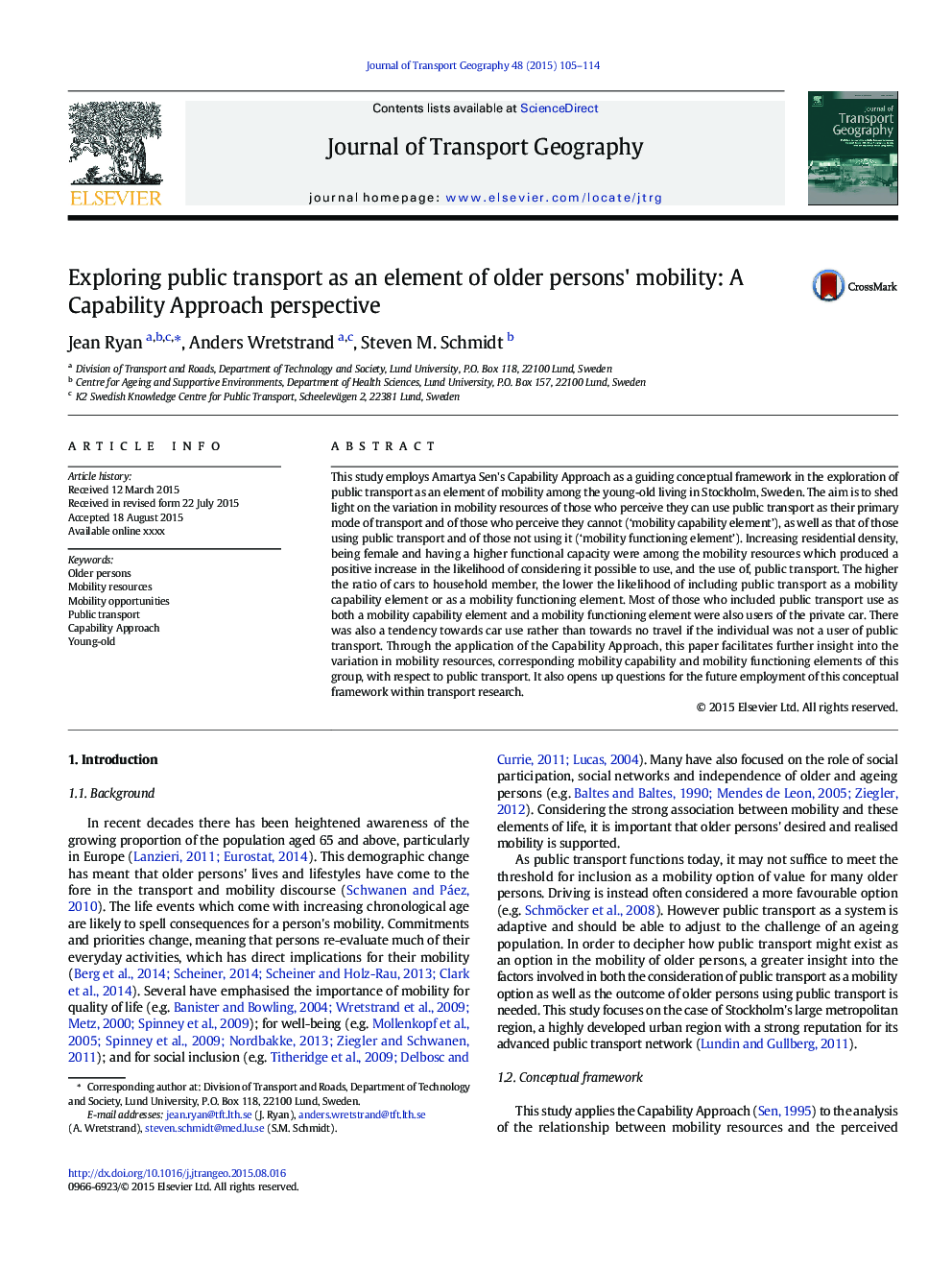| کد مقاله | کد نشریه | سال انتشار | مقاله انگلیسی | نسخه تمام متن |
|---|---|---|---|---|
| 7485795 | 1485419 | 2015 | 10 صفحه PDF | دانلود رایگان |
عنوان انگلیسی مقاله ISI
Exploring public transport as an element of older persons' mobility: A Capability Approach perspective
ترجمه فارسی عنوان
بررسی حمل و نقل عمومی به عنوان عنصری از تحرک افراد مسن: یک دیدگاه رویکرد قابلیت
دانلود مقاله + سفارش ترجمه
دانلود مقاله ISI انگلیسی
رایگان برای ایرانیان
کلمات کلیدی
افراد مسن تر منابع تحرک، فرصت های تحرک، حمل و نقل عمومی، رویکرد قابلیت، جوان پیر،
ترجمه چکیده
این تحقیق، رویکرد توانایی امارتیا سن را به عنوان چارچوب مفهومی هدایت در اکتشاف حمل و نقل عمومی به عنوان عنصری از تحرک در میان زندگی سالم در استکهلم سوئد انجام می دهد. هدف این است که تغییر در منابع تحرک کسانی که درک می کنند می توانند از حمل و نقل عمومی به عنوان روش اولیه حمل و نقل و کسانی که درک نمی کنند (عنصر قابلیت تحرک) و همچنین کسانی که از استفاده عمومی حمل و نقل و کسانی که از آن استفاده نمی کنند (عنصر عملکرد تحرک). افزایش تراکم مسکونی، داشتن زن و داشتن ظرفیت عملکردی بالاتری در بین منابع تحرک بود که موجب افزایش مثبتی در احتمال استفاده از آن و استفاده از حمل و نقل عمومی شد. نسبت خودروها به اعضای خانواده بالاتر است، احتمال انتقال حمل و نقل عمومی به عنوان یک عنصر قابلیت تحرک یا به عنوان یک عنصر عملکردی تحرک کمتر است. اکثر کسانی که حمل و نقل عمومی را به عنوان یک عنصر قابلیت تحرک و یک عنصر عملکردی تحرک نیز استفاده می کردند، نیز استفاده از ماشین شخصی بود. در صورت استفاده شخصی از حمل و نقل عمومی، تمایل به استفاده از خودرو به جای سفر بدون سفر وجود دارد. با استفاده از رویکرد قابلیت، این مقاله بینش بیشتر در مورد تغییر در منابع تحرک، قابلیت تحرک مربوطه و عناصر قابلیت تحرک این گروه را در رابطه با حمل و نقل عمومی تسهیل می کند. این همچنین سوالاتی را برای استخدام آینده این چارچوب مفهومی در تحقیقات حمل و نقل ارائه می دهد.
موضوعات مرتبط
علوم زیستی و بیوفناوری
علوم محیط زیست
علوم زیست محیطی (عمومی)
چکیده انگلیسی
This study employs Amartya Sen's Capability Approach as a guiding conceptual framework in the exploration of public transport as an element of mobility among the young-old living in Stockholm, Sweden. The aim is to shed light on the variation in mobility resources of those who perceive they can use public transport as their primary mode of transport and of those who perceive they cannot ('mobility capability element'), as well as that of those using public transport and of those not using it ('mobility functioning element'). Increasing residential density, being female and having a higher functional capacity were among the mobility resources which produced a positive increase in the likelihood of considering it possible to use, and the use of, public transport. The higher the ratio of cars to household member, the lower the likelihood of including public transport as a mobility capability element or as a mobility functioning element. Most of those who included public transport use as both a mobility capability element and a mobility functioning element were also users of the private car. There was also a tendency towards car use rather than towards no travel if the individual was not a user of public transport. Through the application of the Capability Approach, this paper facilitates further insight into the variation in mobility resources, corresponding mobility capability and mobility functioning elements of this group, with respect to public transport. It also opens up questions for the future employment of this conceptual framework within transport research.
ناشر
Database: Elsevier - ScienceDirect (ساینس دایرکت)
Journal: Journal of Transport Geography - Volume 48, October 2015, Pages 105-114
Journal: Journal of Transport Geography - Volume 48, October 2015, Pages 105-114
نویسندگان
Jean Ryan, Anders Wretstrand, Steven M. Schmidt,
